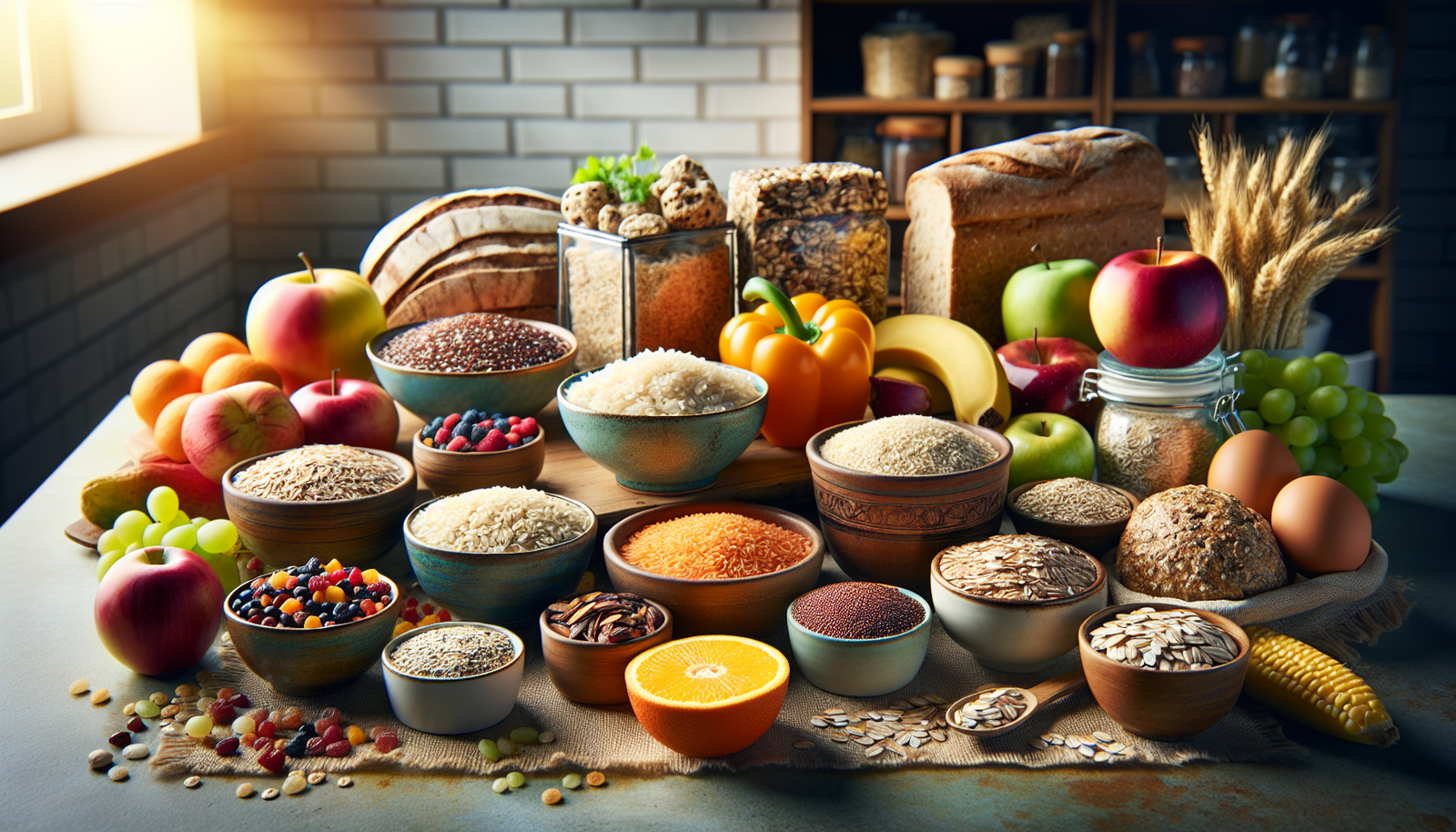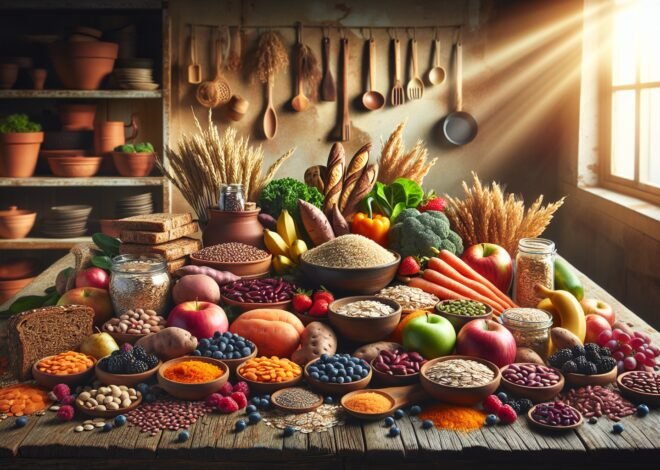
How to Incorporate Whole Grains into Your Diet for Healthy Carbs
Whole grains for healthy carbs offer a nutritious foundation for energy and wellness, making them an essential part of any balanced diet. Studies show that diets rich in whole grains can lower the risk of chronic diseases like heart disease and diabetes. This guide will explore how to seamlessly incorporate various whole grains into your meals, enhancing both flavor and nutritional value. From the versatility of quinoa and the nuttiness of brown rice to the fiber-rich benefits of oats and barley, discover delicious ways to make whole grains a staple in your diet. Embrace a healthier lifestyle and enjoy the sustained energy these carbs provide.
Introduction to Whole Grains for Healthy Carbs
Whole grains are an essential part of a balanced diet, offering numerous health benefits while providing the carbohydrates our bodies need for energy. Unlike refined grains, whole grains retain all parts of the grain—the bran, germ, and endosperm—ensuring you get the most nutrition. This section will delve into the benefits of whole grains, the common types you should consider including in your diet, and their impact on blood sugar levels.
Understanding the Benefits of Whole Grains
Whole grains are packed with nutrients that are crucial for maintaining good health. They are high in fiber, which aids in digestion and helps maintain a healthy weight by promoting a feeling of fullness. Additionally, whole grains are rich in essential vitamins and minerals, including B vitamins, iron, magnesium, and selenium. These nutrients play vital roles in energy metabolism, brain function, and maintaining a robust immune system.
Incorporating whole grains into your diet can also reduce the risk of chronic diseases. Studies have shown that a diet rich in whole grains can lower the risk of heart disease, type 2 diabetes, and certain cancers. This is largely due to the high levels of antioxidants and phytochemicals present in whole grains, which help protect the body from oxidative stress and inflammation.
Common Types of Whole Grains to Include in Your Diet
There is a diverse array of whole grains to choose from, each offering its unique taste and nutritional profile. Some of the most popular whole grains include:
- Brown Rice: A versatile staple that can be used in a variety of dishes.
- Quinoa: A complete protein source, perfect for vegetarians and vegans.
- Oats: Known for their heart-healthy properties, ideal for breakfast.
- Barley: Great for soups and stews, with a chewy texture.
- Farro: An ancient grain that adds a nutty flavor to salads and side dishes.
- Buckwheat: Often used in gluten-free recipes, with a distinctive earthy taste.
Each of these grains provides different health benefits, making it beneficial to incorporate a variety into your meals. By doing so, you ensure a broader spectrum of nutrients, which supports overall health.
The Impact of Whole Grains on Blood Sugar Levels
Whole grains have a significant impact on blood sugar levels, making them an excellent choice for managing diabetes or maintaining stable energy levels throughout the day. The fiber content in whole grains slows down the digestion and absorption of carbohydrates, leading to a more gradual increase in blood sugar levels. This effect helps in preventing spikes and crashes, which are common with refined grains.
Furthermore, whole grains have a lower glycemic index compared to their refined counterparts. This means they cause a slower rise in blood sugar levels. Consuming whole grains as part of a balanced diet can contribute to better glycemic control and reduce insulin resistance over time.
People with diabetes or those looking to maintain healthy blood sugar levels should prioritize whole grains over refined ones. Not only do they provide long-lasting energy, but they also support overall metabolic health.
Easy Ways to Incorporate Whole Grains into Your Daily Meals
Incorporating whole grains into your diet doesn’t have to be difficult. With a bit of creativity and planning, you can enjoy their health benefits in every meal. From breakfast to snacks, there are endless ways to make whole grains a staple in your diet. This section will provide practical ideas for adding whole grains to your breakfast, lunch, dinner, and even snacks.
Whole Grain Breakfast Ideas for a Nutritious Start
Starting your day with whole grains can set the tone for a healthy and energetic day. Here are some breakfast ideas that embrace whole grains:
- Overnight Oats: Combine oats with milk or yogurt and your favorite toppings, like fruits and nuts, for a quick, nutritious breakfast.
- Quinoa Porridge: Cook quinoa with almond milk and cinnamon, and top with fresh berries for a protein-packed meal.
- Whole Grain Pancakes: Use whole wheat flour or buckwheat flour to make pancakes that are high in fiber and flavor.
- Smoothie Bowls with Grains: Add cooked millet or amaranth to your smoothie bowls for added texture and nutrients.
These ideas can be easily customized to suit your taste preferences, ensuring that you enjoy every bite while nourishing your body.
Transform Your Lunch and Dinner with Whole Grains
Whole grains can elevate your lunch and dinner, providing a wholesome base for many dishes. Consider incorporating these ideas into your meals:
- Grain Bowls: Start with a base of brown rice or farro, and top with vegetables, proteins, and a flavorful sauce.
- Whole Grain Salads: Use quinoa or bulgur as the base for a hearty salad, adding fresh herbs, cheese, and a zesty dressing.
- Grain-Stuffed Vegetables: Fill bell peppers or zucchini with a mixture of barley or couscous, along with spices and vegetables.
- Whole Wheat Pasta: Swap regular pasta for whole wheat versions to increase fiber intake without sacrificing taste.
These dishes not only provide essential nutrients but also offer satisfying flavors that make healthy eating enjoyable.
Creative Snacks Featuring Whole Grains
Snacking can be both delicious and nutritious when whole grains are involved. Try these creative snack ideas to incorporate whole grains into your diet:
- Popcorn with Nutritional Yeast: A light and crunchy snack that satisfies cravings while delivering fiber.
- Whole Grain Crackers with Hummus: Opt for crackers made from whole grains and pair them with your favorite dips.
- Granola Bars: Make your own using oats, seeds, and dried fruits for a personalized, on-the-go snack.
- Rice Cakes with Nut Butter: Top brown rice cakes with almond or peanut butter for a quick, energy-boosting snack.
These snacks are not only easy to prepare but also keep you full and energized between meals.
Tips for Choosing and Preparing Whole Grains
Choosing the right whole grains and preparing them properly can enhance their nutritional value and ensure a delicious outcome. This section offers guidance on identifying whole grain products, cooking techniques that preserve nutrients, and tips for storing grains to maintain their freshness.
How to Read Labels and Identify Whole Grain Products
Choosing whole grain products requires a bit of label-reading savvy. Look for these indicators to ensure you’re selecting true whole grain options:
- Check the Ingredient List: The first ingredient should be a whole grain, such as whole wheat, oats, or brown rice.
- Look for the Whole Grain Stamp: This stamp, often found on packaging, indicates a product contains at least half a serving of whole grains.
- Beware of Misleading Terms: Words like “multi-grain” or “made with whole grain” don’t guarantee a product is predominantly whole grain.
By paying attention to these details, you can make informed choices that support your health goals.
Cooking Techniques to Preserve Nutrients in Whole Grains
Proper cooking methods can maximize the nutritional benefits of whole grains. Here are some techniques to keep in mind:
- Rinse Grains: Washing grains like quinoa can remove bitter saponins, improving taste and digestibility.
- Use the Right Water Ratio: Follow package instructions for the ideal water-to-grain ratio to ensure grains are cooked, not mushy.
- Avoid Overcooking: Overcooked grains can lose texture and some nutrients. Aim for a slightly chewy consistency.
These techniques ensure you get the most out of your whole grains, both in nutrition and flavor.
Storing Whole Grains for Freshness and Longevity
Proper storage of whole grains can prevent spoilage and preserve their quality. Here’s how to store them correctly:
- Use Airtight Containers: Keep grains in airtight containers to protect them from moisture and pests.
- Store in a Cool, Dry Place: A pantry or cupboard away from heat sources is ideal for most grains.
- Refrigerate or Freeze: For longer storage, refrigerate or freeze grains. This is especially useful for grains like brown rice, which can go rancid quickly due to its oil content.
By following these storage tips, your whole grains will stay fresh and ready for use in a variety of dishes.
Conclusion
Whole grains are a healthier carbohydrate choice compared to refined grains. They contain more nutrients, including fiber, which aids digestion and provides a feeling of fullness. Consuming whole grains can help regulate blood sugar levels and reduce the risk of chronic diseases. They provide essential vitamins and minerals such as B vitamins, iron, and magnesium. Incorporating whole grains into daily meals supports overall health and well-being.
FAQ
What are the benefits of whole grains for healthy carbohydrate intake?
Whole grains provide essential nutrients and fiber, supporting digestive health. They maintain steady blood sugar levels, offering a consistent energy source. Rich in vitamins and minerals, whole grains contribute to overall wellness.
How do whole grains compare to refined grains in terms of health benefits?
Whole grains retain bran, germ, and endosperm, offering more nutrients and fiber than refined grains. They help reduce the risk of heart disease, obesity, and type 2 diabetes, whereas refined grains often lose nutrients during processing.
Which whole grains are best for a balanced diet and long-lasting energy?
Oats, quinoa, brown rice, and barley are excellent choices for sustained energy. These grains are high in fiber and nutrients, promoting satiety and supporting metabolic health.
Can whole grains help with weight management and promote fullness?
Yes, whole grains are rich in fiber, which enhances feelings of fullness and can reduce overall calorie intake. This supports weight management by helping control hunger between meals.
How can I incorporate more whole grains into my daily meals?
Start by replacing white rice with brown rice or quinoa. Opt for whole grain bread and pasta. Adding oatmeal to your breakfast routine or snacking on popcorn can also increase whole grain consumption.
Are there any potential allergens or side effects associated with consuming whole grains?
Some people may experience gluten sensitivity, primarily with grains like wheat, barley, and rye. Others might have allergies to specific grains. It’s important to monitor any adverse reactions and consult with a healthcare provider if necessary.











